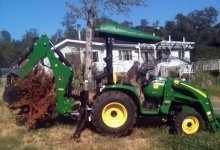Dogtrainer
Member
The last two days have been spent digging out an oak stump with my new John Deere 3320 and 485 backhoe. *I only put in about 2 hours each day but the hoe shuck me up pretty good the first day.
* The start of the second day I started out the say way, HIGH RPM AND SHAKE RATTLE AND ROLL, *but then the FOG part of me *(F#%^ old guy) kicked in and said slow down, lower the rpm and scratch away at the hole till you find the roots and rocks and work on them slowly. *
* The work went faster, the rocks came out easier and the roots were exposed and broken one by one. *Then it was time to scratch away at the dirt under the stump. * I was able to accomplish 3 times the work the second day as I did the first day. * Pretty soon I saw the stump starting to rock, then sway, then lean and SNAP! *DONE! *
* In one post here I read about the guy trying to dig a stump and then a pro came in and finessed the stump from the hole. *I can see this as completely true, *just because you take large bucket loads and hit the rocks hard doesn't mean you are going to be faster, just sore'er. * *Thank you for this forum!
* The start of the second day I started out the say way, HIGH RPM AND SHAKE RATTLE AND ROLL, *but then the FOG part of me *(F#%^ old guy) kicked in and said slow down, lower the rpm and scratch away at the hole till you find the roots and rocks and work on them slowly. *
* The work went faster, the rocks came out easier and the roots were exposed and broken one by one. *Then it was time to scratch away at the dirt under the stump. * I was able to accomplish 3 times the work the second day as I did the first day. * Pretty soon I saw the stump starting to rock, then sway, then lean and SNAP! *DONE! *
* In one post here I read about the guy trying to dig a stump and then a pro came in and finessed the stump from the hole. *I can see this as completely true, *just because you take large bucket loads and hit the rocks hard doesn't mean you are going to be faster, just sore'er. * *Thank you for this forum!
